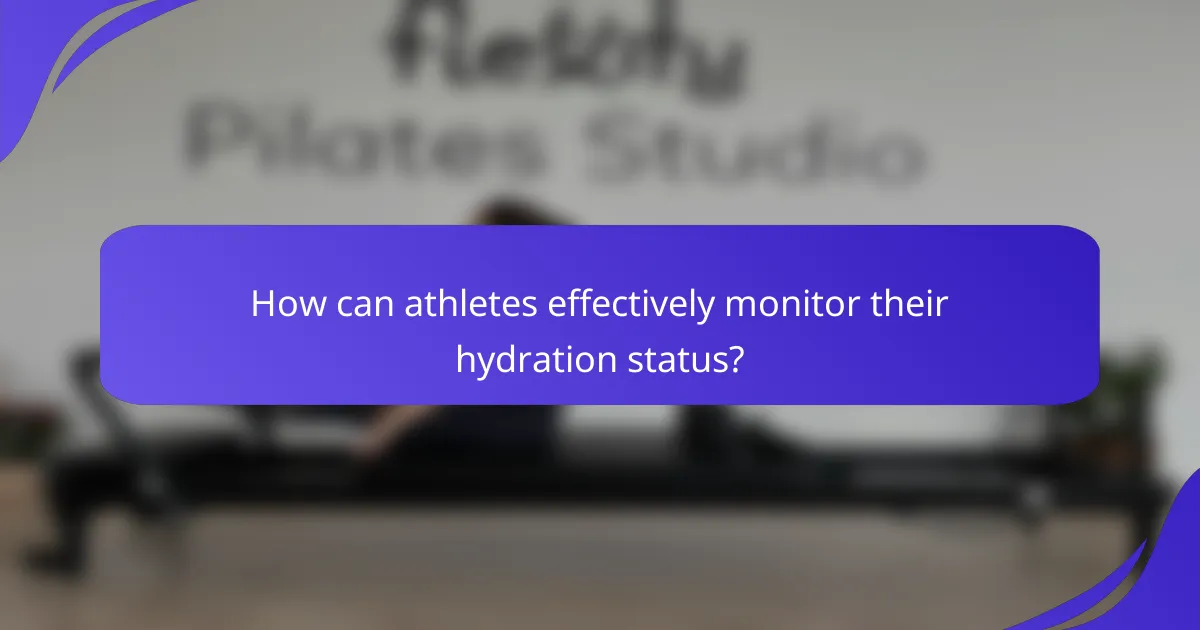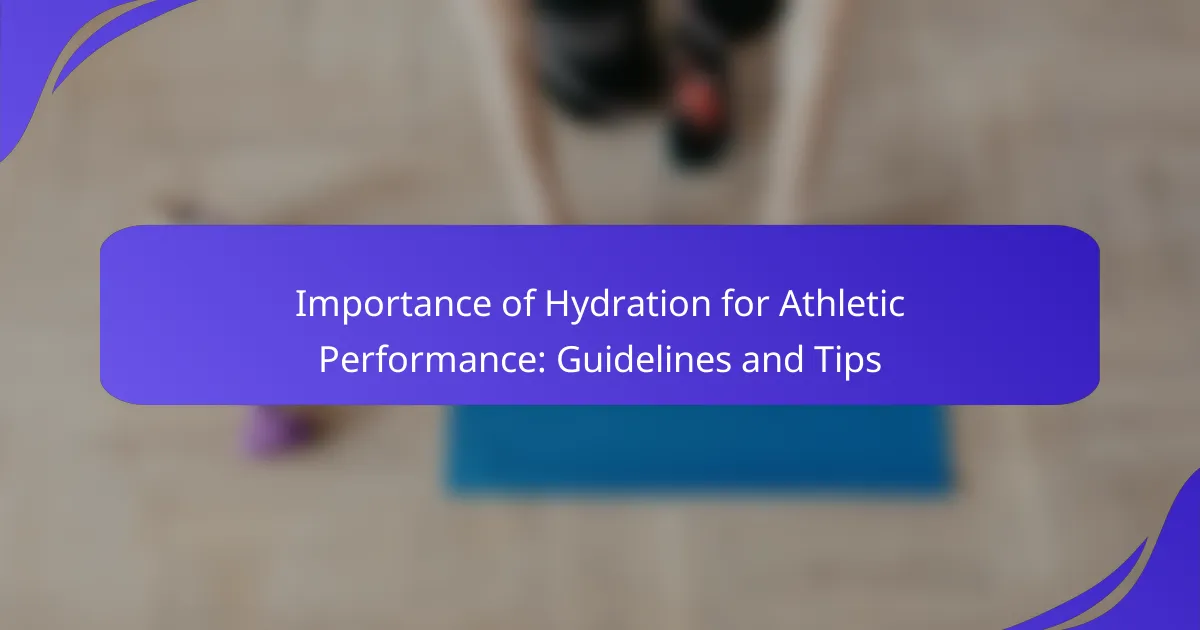Hydration is crucial for athletic performance, impacting endurance, strength, and recovery. Athletes must understand fluid intake guidelines, unique hydration strategies for different sports, and monitor hydration status effectively. Addressing challenges like electrolyte imbalances and heat acclimatization is essential for maintaining peak performance. Consistent hydration practices can significantly enhance overall athletic outcomes.

Why is Hydration Crucial for Athletic Performance?
Hydration is essential for athletic performance as it directly impacts endurance, strength, and recovery. Proper fluid intake helps regulate body temperature, maintain electrolyte balance, and prevent fatigue. Dehydration can lead to decreased coordination, increased perceived effort, and impaired cognitive function. Athletes should aim to drink water before, during, and after exercise, adjusting their intake based on activity duration and intensity. For example, a loss of just 2% of body weight due to sweating can impair performance significantly.
What are the physiological effects of dehydration on athletes?
Dehydration negatively impacts athletes by impairing performance, increasing fatigue, and raising injury risk. It leads to decreased endurance, reduced strength, and impaired cognitive function. Maintaining hydration is crucial for optimal athletic performance, as even mild dehydration can cause significant declines in physical capabilities. Studies show that a loss of just 2% body weight from fluid loss can affect performance, emphasizing the importance of regular fluid intake during training and competition.
How does hydration influence endurance and strength?
Hydration significantly enhances both endurance and strength in athletes. Proper fluid balance maintains optimal physiological functions, preventing fatigue and improving performance. Dehydration can lead to decreased strength, slower reactions, and impaired endurance. Studies indicate that even a 2% loss in body weight from fluid loss can negatively impact performance. Staying hydrated supports muscle function and recovery, making it essential for athletes aiming to maximize their potential.

What are the universal hydration needs for athletes?
Athletes universally need to maintain hydration for optimal performance. Guidelines suggest consuming 500-700 mL of water two to three hours before exercise and 200-300 mL during workouts. Electrolyte-rich drinks are beneficial for prolonged activities. Individual hydration needs vary based on factors like duration, intensity, and environmental conditions. Regular monitoring of body weight and urine color can help assess hydration status.
How much water do athletes need before, during, and after exercise?
Athletes need approximately 500 to 700 mL of water two to three hours before exercise, followed by 200 to 300 mL every 10 to 20 minutes during activity, and 450 to 675 mL within 30 minutes after exercise. Hydration enhances performance, reduces fatigue, and aids recovery. Individual needs may vary based on factors like climate, exercise intensity, and duration. Consistent hydration practices contribute to overall athletic success.
What role do electrolytes play in hydration?
Electrolytes are essential for optimal hydration and athletic performance. They help maintain fluid balance, regulate muscle contractions, and support nerve function. Key electrolytes include sodium, potassium, and magnesium, which are lost through sweat and need to be replenished for effective hydration. Proper electrolyte levels enhance endurance and reduce the risk of cramps and fatigue during intense physical activity.
Which electrolytes are most important for athletes?
Sodium, potassium, calcium, and magnesium are the most important electrolytes for athletes. These minerals help regulate fluid balance, muscle contractions, and nerve function. Sodium maintains blood pressure and volume, while potassium is crucial for muscle function and preventing cramps. Calcium supports muscle contractions and bone health, and magnesium aids in energy production and recovery. Proper electrolyte balance enhances performance and reduces the risk of dehydration-related issues.

What unique hydration strategies exist for different sports?
Unique hydration strategies vary by sport to optimize performance. Endurance athletes, like marathon runners, benefit from electrolyte-rich drinks to maintain stamina. Team sports, such as soccer, often require quick hydration breaks with water or isotonic beverages to prevent fatigue. Strength training athletes may focus on hydration pre- and post-workout, using water and protein shakes. Additionally, high-altitude sports necessitate increased fluid intake due to dehydration risks. Each strategy is tailored to specific demands, ensuring athletes maintain peak performance.
How should hydration strategies vary between endurance and team sports?
Hydration strategies should differ for endurance and team sports based on duration and intensity. Endurance athletes require consistent fluid intake to replace losses over long durations, often using electrolyte solutions. In contrast, team sports athletes need hydration focused on pre-game and during-game intervals to maintain performance during short bursts of activity.
Endurance sports typically see athletes consuming around 500-1000 mL of fluid per hour, depending on sweat rates. Team sports may require 200-300 mL every 15-20 minutes to optimize performance.
Additionally, endurance athletes often utilize carbohydrate-electrolyte drinks to sustain energy levels, while team sports may benefit from water and quick-replenishing snacks during breaks.
Ultimately, tailoring hydration to the specific demands of the sport enhances performance and recovery, making it essential for athletes to understand their unique needs.
What are the hydration needs for high-altitude athletes?
High-altitude athletes have increased hydration needs due to lower oxygen levels and drier air. They should consume 3 to 4 liters of water daily to maintain optimal performance. Dehydration can lead to altitude sickness and decreased endurance. Monitoring urine color can help athletes gauge hydration levels effectively.

What are the rare hydration challenges faced by athletes?
Athletes face rare hydration challenges that can significantly impact performance. These include electrolyte imbalances, heat acclimatization issues, and gastrointestinal distress.
Electrolyte imbalances can occur due to excessive sweating, leading to muscle cramps and fatigue. Heat acclimatization challenges arise when athletes train in extreme temperatures, affecting their ability to maintain hydration levels. Gastrointestinal distress may result from consuming large amounts of fluid during intense exercise, causing discomfort and hindering performance.
Understanding these rare challenges helps athletes implement effective hydration strategies tailored to their specific needs.
How does climate affect hydration requirements?
Climate significantly influences hydration needs for athletes. Higher temperatures and humidity levels increase sweat loss, necessitating greater fluid intake. For example, athletes may require up to 2-3 liters of water daily in hot conditions. Additionally, altitude can also affect hydration, as drier air leads to increased respiratory fluid loss. Proper hydration supports performance, aids recovery, and reduces the risk of heat-related illnesses. Monitoring fluid intake and adjusting based on environmental factors is essential for optimal athletic performance.
What are the hydration considerations for athletes with specific health conditions?
Athletes with specific health conditions must prioritize hydration to optimize performance and prevent complications. Conditions like diabetes, kidney disease, and cardiovascular issues require tailored hydration strategies.
Diabetes management involves monitoring fluid intake, as dehydration can affect blood sugar levels. Athletes should aim for consistent hydration, focusing on water and electrolyte balance.
For kidney disease, fluid intake must be regulated based on individual health status. Athletes should consult healthcare providers to establish safe hydration levels that prevent strain on the kidneys.
Cardiovascular conditions necessitate careful hydration to avoid excessive strain on the heart. Athletes should monitor their hydration levels closely, ensuring they remain adequately hydrated without overhydration, which can lead to complications.
In summary, hydration considerations vary based on health conditions, necessitating personalized strategies for optimal athletic performance.

How can athletes effectively monitor their hydration status?
Athletes can effectively monitor hydration status by regularly checking urine color, using hydration apps, and tracking fluid intake. These methods provide real-time insights into hydration levels.
Urine color is a practical indicator; pale yellow suggests proper hydration, while darker shades indicate dehydration. Hydration apps can remind athletes to drink fluids and log their intake, promoting awareness. Additionally, athletes should weigh themselves before and after workouts to assess fluid loss, aiming to replace any deficits promptly.
What methods can be used to assess hydration levels?
Hydration levels can be assessed using various methods, including urine color analysis, weight changes, and thirst perception. These methods provide athletes with insights into their hydration status, which is crucial for optimal performance.
Urine color analysis is a simple and effective way to gauge hydration. A pale yellow color indicates proper hydration, while darker shades suggest dehydration. Weight changes can also indicate hydration levels; losing more than 2% of body weight during exercise often signals inadequate fluid intake. Thirst perception is another subjective measure; athletes should drink when they feel thirsty, but relying solely on this can lead to dehydration in some cases.
Combining these methods offers a comprehensive approach to monitoring hydration, ensuring athletes maintain optimal performance levels.
How can technology aid in hydration tracking?
Technology aids hydration tracking by providing real-time data and personalized insights. Wearable devices and mobile apps monitor fluid intake and dehydration levels, enhancing athletic performance. Features like reminders and hydration goals help maintain optimal hydration, crucial for endurance and recovery. Advanced sensors can measure sweat loss, offering tailored hydration strategies.

What are the best practices for optimizing hydration?
To optimize hydration for athletic performance, prioritize consistent fluid intake throughout the day. Aim for at least 3 liters for men and 2.2 liters for women daily. Monitor hydration status through urine color; pale yellow indicates proper hydration. Incorporate electrolytes during intense workouts lasting over an hour to maintain performance and prevent cramps. Adjust fluid intake based on climate and activity level, as heat increases sweat loss.
What common mistakes do athletes make regarding hydration?
Athletes often make hydration mistakes that can hinder performance. Common errors include ignoring thirst cues, underestimating fluid needs, and relying solely on water. Many athletes fail to hydrate adequately before events, leading to dehydration. Additionally, consuming excessive caffeine or alcohol can further exacerbate hydration issues. Proper hydration strategies, including electrolyte balance, are essential for optimal athletic performance.
How can athletes develop a personalized hydration plan?
Athletes can develop a personalized hydration plan by assessing their individual sweat rate, activity level, and environmental conditions. Start by measuring fluid loss during workouts to determine hydration needs.
1. Calculate sweat rate: Weigh yourself before and after exercise. Each pound lost equals approximately 16 ounces of fluid.
2. Consider activity duration: For activities lasting over an hour, include electrolyte-rich beverages to replenish lost salts.
3. Adjust for climate: Increase fluid intake in hot or humid conditions to prevent dehydration.
4. Monitor urine color: Aim for light yellow, indicating proper hydration levels.
5. Create a schedule: Plan hydration breaks during training and competitions for consistent fluid intake.
These steps help tailor hydration strategies, optimizing performance and recovery.
What tools or resources can assist in creating a hydration plan?
Several tools and resources can help create an effective hydration plan. Hydration apps track fluid intake and remind athletes to drink water. Sports nutritionists provide personalized guidance based on individual needs. Additionally, hydration calculators estimate fluid requirements based on activity level and environmental conditions. Lastly, wearable devices monitor sweat loss and hydration status, offering real-time feedback.



